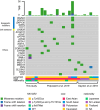Genetic profiles and clinical features in subcutaneous panniculitis-like T-cell lymphomas
- PMID: 39288772
- PMCID: PMC11531942
- DOI: 10.1111/cas.16345
Genetic profiles and clinical features in subcutaneous panniculitis-like T-cell lymphomas
Abstract
Subcutaneous panniculitis-like T-cell lymphoma (SPTCL) is a rare peripheral T-cell lymphoma characterized by cutaneous lesions and immunologic manifestations. The five-year survival rate of SPTCL has been reported to be over 80%, indicating a favorable prognosis. Recent studies have uncovered recurrent germline variants in HAVCR2, encoding an immunomodulator. In this study, we integrated whole-exome sequencing data from 60 samples collected from 36 SPTCL patients, encompassing six patients of our cohort and 30 patients of publicly available data. We identified 138 somatic mutations in skin tumors of 24 patients and HAVCR2 germline mutations in 23 of 29 patients. HAVCR2 p.Tyr82Cys mutations were identified in four of six Japanese patients. During the clinical courses of four patients, cyclophosphamide, hydroxydaunomycin, vincristine, and prednisone were administered to all patients, but it resulted in incomplete responses in all four patients. However, disease conditions of all patients remained stable with additional treatment, including autologous peripheral blood stem cell transplantation. Over a 7.5-year median follow-up, one patient developed autoimmune-related diseases, while one developed other hematological malignancy, resulting in death. To our knowledge, this is the first report of recurrent HAVCR2 germline mutations in Japanese patients, suggesting the necessity for long-term follow-up.
Keywords: HAVCR2 mutation; germline mutation; hematology; lymphoma; subcutaneous panniculitis‐like T‐cell lymphoma.
© 2024 The Author(s). Cancer Science published by John Wiley & Sons Australia, Ltd on behalf of Japanese Cancer Association.
Conflict of interest statement
We have the following relationship to disclose: M.S.‐Y. is a one of the members of the editorial board of
Figures



References
MeSH terms
Substances
Supplementary concepts
Grants and funding
LinkOut - more resources
Full Text Sources
Research Materials

